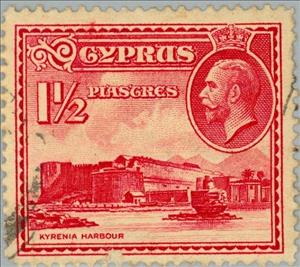Stamp: King George V & Kyrenia Castle and Harbor (Cyprus 1934)
King George V & Kyrenia Castle and Harbor (Cyprus 1934)
01 December (Cyprus ) within release King George V and Views goes into circulation Stamp King George V & Kyrenia Castle and Harbor face value 1½ Cypriot piastre
| Stamp King George V & Kyrenia Castle and Harbor in catalogues | |
|---|---|
| Michel: | Mi:CY 122 |
| Stamp Number: | Sn:CY 129 |
| Yvert et Tellier: | Yt:CY 120 |
| Stanley Gibbons: | Sg:CY 137 |
Stamp is horizontal format.
Also in the issue King George V and Views:
- Stamp - Ruins of Vouni Palace face value ¼;
- Stamp - King George V & Ancient Salamis Theatre face value ½;
- Stamp - King George V & Peristerona Church and Mosque face value ¾;
- Stamp - King George V & Ancient Soli Theatre face value 1;
- Stamp - King George V & Kyrenia Castle and Harbor face value 1½;
- Stamp - King George V & Kolossi Castle face value 2½;
- Stamp - Cathedral of St Sophia, Nicosia face value 4½;
- Stamp - Bairakdar Mosque face value 6;
- Stamp - Queen's Window, St Hilarion Castle face value 9;
- Stamp - Buyuk Khan Inn, Nicosia face value 18;
- Stamp - Forest Scene face value 45;
Stamp King George V & Kyrenia Castle and Harbor it reflects the thematic directions:
A head of state (or chief of state) is the public persona that officially represents the national unity and legitimacy of a sovereign state. In some countries, the head of state is a ceremonial figurehead with limited or no executive power, while in others, the head of state is also the head of government. In countries with parliamentary governments, the head of state is typically a ceremonial figurehead that does not actually guide day-to-day government activities and may not be empowered to exercise any kind of secular political authority (e.g., Queen Elizabeth II as Head of the Commonwealth). In countries where the head of state is also the head of government, the president serves as both a public figurehead and the actual highest ranking political leader who oversees the executive branch (e.g., the President of the United States).
A port is a maritime facility comprising one or more wharves or loading areas, where ships load and discharge cargo and passengers. Although usually situated on a sea coast or estuary, ports can also be found far inland, such as Hamburg, Manchester and Duluth; these access the sea via rivers or canals. Because of their roles as ports of entry for immigrants as well as soldiers in wartime, many port cities have experienced dramatic multi-ethnic and multicultural changes throughout their histories
King is the title given to a male monarch in a variety of contexts. The female equivalent is queen regnant (while the title of queen on its own usually refers to the consort of a king). In the context of prehistory, antiquity and contemporary indigenous peoples, the title may refer to tribal kingship. Germanic kingship is cognate with Indo-European traditions of tribal rulership (c.f. Indic rājan, Gothic reiks, and Old Irish rí, etc.) In the context of classical antiquity, king may translate Latin rex or either Greek archon or basileus. In classical European feudalism, the title of king as the ruler of a kingdom is understood as the highest rank in the feudal order, potentially subject, at least nominally, only to an emperor (harking back to the client kings of the Roman Empire). In a modern context, the title may refer to the ruler of one of a number of modern monarchies (either absolute or constitutional). The title of king is used alongside other titles for monarchs, in the West prince, emperor, archduke, duke or grand duke, in the Middle East sultan or emir; etc. Kings, like other royalty, tend to wear purple because purple was an expensive color to wear in the past.
A castle (from Latin: castellum) is a type of fortified structure built in Europe and the Middle East during the Middle Ages by European nobility. Scholars debate the scope of the word castle, but usually consider it to be the private fortified residence of a lord or noble. This is distinct from a palace, which is not fortified; from a fortress, which was not always a residence for nobility; and from a fortified settlement, which was a public defence – though there are many similarities among these types of construction. Usage of the term has varied over time and has been applied to structures as diverse as hill forts and country houses. Over the approximately 900 years that castles were built, they took on a great many forms with many different features, although some, such as curtain walls and arrowslits, were commonplace.




